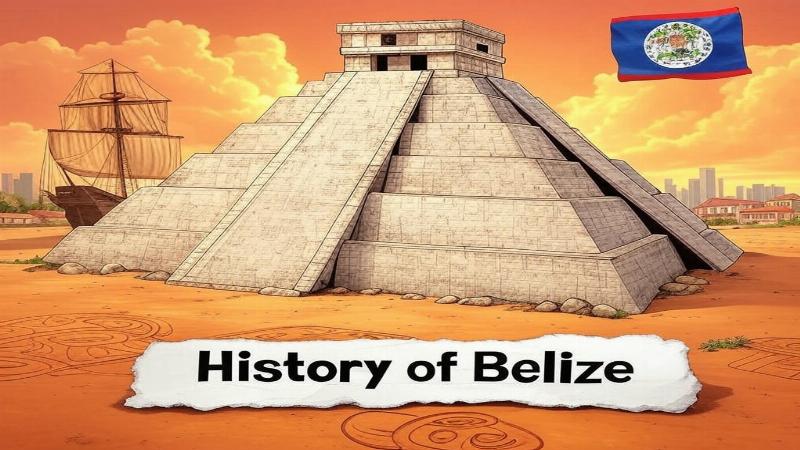Place for ads

Belize, a small nation on Central America’s eastern coast, is a land where ancient ruins meet Caribbean vibes. Covering 22,966 square kilometers, it nestles between Mexico, Guatemala, and the Caribbean Sea, its jungles and reefs hiding a rich past. Known today for its biodiversity and laid-back charm, Belize’s history spans millennia, shaped by Maya civilizations, European colonizers, and a vibrant mix of cultures. In this article, we’ll trace Belize’s journey from its earliest days to its modern identity, uncovering the forces that have defined this unique country.
Belize’s human story begins around 9000 BCE, with Paleo-Indian hunters roaming its plains. Archaeological finds—like spear points at Ladyville—suggest they tracked game across a drier landscape before rising seas shaped the coast. By 2000 BCE, the Archaic period brought proto-farmers, growing maize and manioc, as seen in caves like Actun Tunichil Muknal.
The Preclassic Maya arrived around 1500 BCE, transitioning from nomads to settlers. Sites like Cuello reveal pottery and early villages, laying roots for a civilization that would dominate Belize for centuries. These early peoples adapted to swamps and forests, setting the stage for a golden age.
By 300 BCE, the Maya flourished
Place for ads
The 9th-century Maya collapse—likely from drought or war—emptied cities, but some, like Lamanai, persisted into the Postclassic (900–1500 CE). By the time Europeans arrived, Maya villages dotted Belize, their numbers thinned but resilient, ready to face a new wave of change.
In 1502, Christopher Columbus sailed near Belize’s coast, but Spain focused on richer lands. Spanish explorers clashed with the Maya in the 1540s—Hernán Cortés passed through in 1525—but rugged terrain and resistance deterred settlement. Shipwrecks, like the 1511 *Santa María de la Barca*, left survivors who blended with locals, hinting at early European traces.
The British arrived in the 1630s—shipwrecked sailors and loggers, called Baymen, cut logwood for dye. By 1667, they settled along the Belize River, defying Spanish claims. Pirates like Peter Wallace—legendary founder of Belize Town—raided Spanish ships, turning the coast into a lawless haven.
Spain and Britain sparred over Belize, with battles like the 1798 Battle of St. George’s Caye—where Baymen and enslaved Africans repelled a Spanish fleet—securing British dominance. The 1859 Anglo-Guatemalan Treaty formalized Britain’s hold, though Guatemala claimed Belize into the 20th century.
Logging boomed—mahogany replaced logwood by the 1800s—worked by enslaved Africans brought from Jamaica and beyond. By 1838, when Britain abolished slavery, over 5,000 freed people shaped Belize’s Creole culture, blending African, British, and Maya roots in towns like Belize City.
The 19th century saw Belize—named British Honduras in 1862—grow as a Crown Colony. Mahogany barons ruled, but the 1931 hurricane, killing 2,500, crippled Belize City, shifting the capital to Belmopan in 1970. Garifuna settlers—descendants of Caribs and Africans—arrived in 1832, enriching Dangriga with drumming and dance.
Economic woes sparked unrest—the 1934 riots demanded jobs and rights. World War II saw Belizeans serve Britain, while post-war nationalism grew. George Price, a Creole leader, emerged, pushing self-rule through the People’s United Party (PUP), setting Belize on a path to independence.
In 1964, British Honduras gained self-government, with Price as premier. Guatemala’s claim delayed full sovereignty, but British troops deterred invasion. On September 21, 1981, Belize became independent, keeping Queen Elizabeth II as monarch via a governor-general. Price, its first prime minister, championed neutrality.
Early independence balanced growth and identity—Belize joined the UN and CARICOM, while tourism rose, spotlighting reefs and ruins. The 1991 border agreement with Guatemala eased tensions, though disputes lingered, resolved by a 2019 referendum favoring international arbitration.
Today, Belize’s 400,000 people reflect a mosaic—Creole, Maya, Garifuna, Mestizo, and Mennonite farmers from the 1950s. Belize City hums with trade, while Belmopan plans a sustainable future. Tourism and agriculture—sugar, citrus, bananas—drive the economy, with the Great Blue Hole a global draw.
Challenges remain—poverty, crime, and climate threats like hurricanes test resilience. Culture thrives—Garifuna Settlement Day, Maya deer dances—and conservation protects jaguars and coral. Belize’s small size belies its big heart, a bridge between continents and eras.
Belize’s history is a vibrant thread—from Maya pyramids to pirate lairs, colonial toil to modern freedom. Its jungles whisper of ancient glory, its shores sing of survival. As Belize strides forward, its past fuels a story of diversity and defiance in the Caribbean sun.
Place for ads